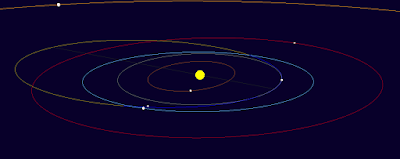Asteroid 2017 QF3 passed by the Earth at a distance of about 553 100
km (1.44 times the average distance between the Earth and the Moon, or
0.37% of the distance between the Earth and the Sun), slightly before 10.55 pm
GMT on Tuesday 23 August 2017. There was no danger of
the asteroid hitting us, though were it to do so it would not have
presented a significant threat. 2017 QF3 has an estimated
equivalent
diameter of 4-16 m (i.e. it is estimated that a spherical object
with
the same volume would be 4-16 m in diameter), and an object of this
size would be expected to explode in
an airburst (an explosion caused by superheating from friction with the
Earth's atmosphere, which is greater than that caused by simply
falling, due to the orbital momentum of the asteroid) in the atmosphere
between 43 and 25 km above the ground, with only fragmentary material
reaching the Earth's surface.
The calculated orbit of 2017 QF3 Minor Planet Center.
2017 QF3 has a 507 day orbital period and an eccentric orbit
tilted at an angle of 2.50° to the plane of the Solar System, which
takes it from 0.70 AU from the Sun (i.e. 70% of he average distance at
which the Earth orbits the Sun, roughly distance at which the
planet
Venus orbits the Sun) to 1.79 AU from the Sun (i.e. 179% of the
average distance at which the Earth orbits the Sun, and more distant from the Sun than the planet Mars). It is therefore
classed as an
Apollo Group Asteroid (an asteroid that is on average further from the
Sun than the Earth, but which does get closer). This means that close
encounters between the asteroid and Earth are extremely common, with the
last having occurred in March 2015 and the next predicted
in Mach 2029.
2017 QF3 also
has frequent close encounters with the planets Venus, which it is
thought to have last passed in June 2016, Mars which it last came close to in March 1968. Asteroids
which make close passes to multiple planets are considered to be in
unstable orbits, and are often eventually knocked out of these orbits by
these encounters, either being knocked onto a new, more stable orbit,
dropped into the Sun, knocked out of the Solar System or occasionally
colliding with a planet.
See also...
Follow Sciency Thoughts on Facebook.







